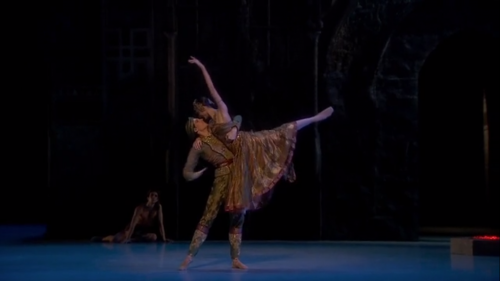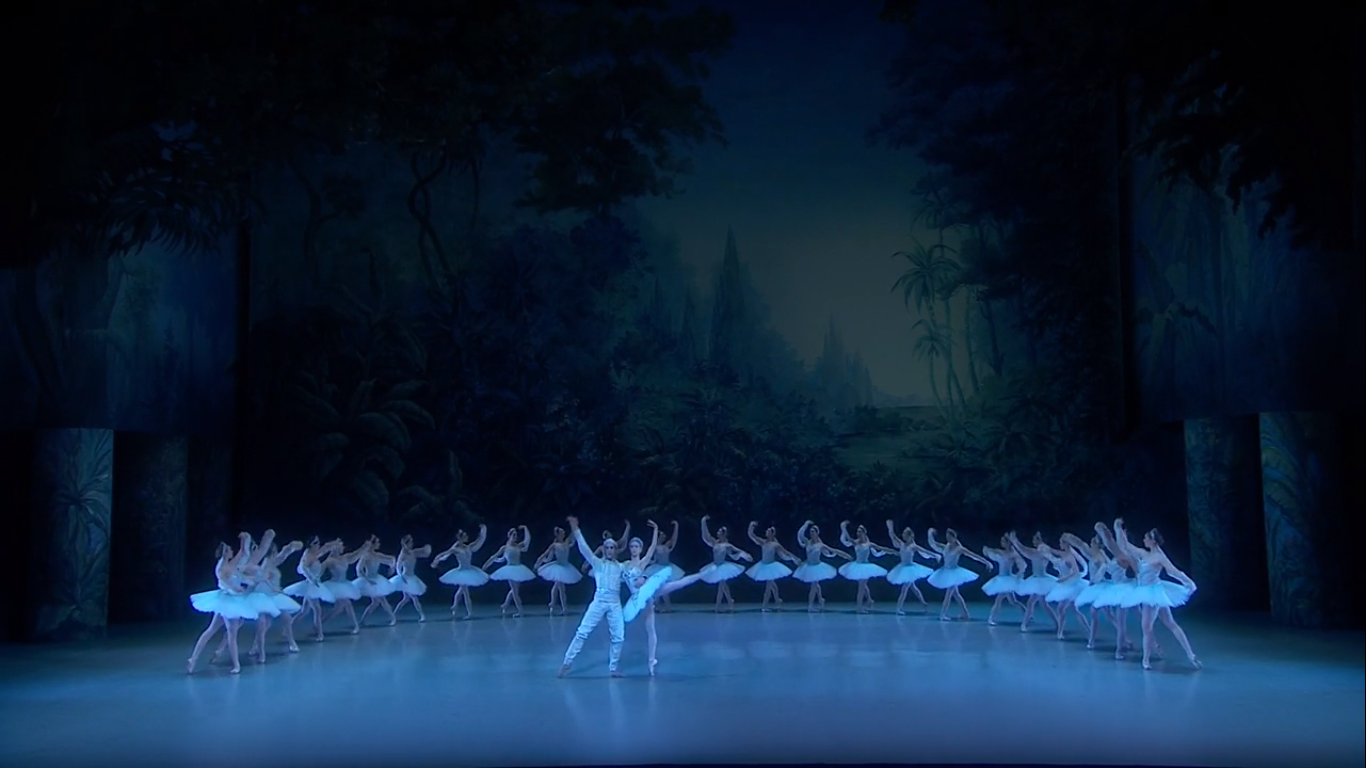 France Rudolf Nureyev’s La Bayadère: Dancers of the Ballet de l’Opéra national de Paris, Orchestre de l’Opéra national de Paris / Philippe Hui (conductor). Livestream (available for only seven day click here) from the Opéra Bastille, Paris, 13.12.2020. (JPr)
France Rudolf Nureyev’s La Bayadère: Dancers of the Ballet de l’Opéra national de Paris, Orchestre de l’Opéra national de Paris / Philippe Hui (conductor). Livestream (available for only seven day click here) from the Opéra Bastille, Paris, 13.12.2020. (JPr)

Production:
Libretto – Marius Petipa and Sergey Khudyakov
Music – Ludwig Minkus (arr. John Lanchbery)
Choreography and Staging – Rudolf Nureyev
Set design – Ezio Frigerio
Costume design – Franca Squarciapino
Lighting design – Vinicio Cheli
Cast included:
Nikiya – Dorothée Gilbert / Amandine Albisson / Myriam Ould-Braham
Solor – Germain Louvet / Hugo Marchand / Mathias Heymann
Gamzatti – Léonore Baulac / Valentine Colasante
The High Brahmin – Vincent Chaillet
The Golden Idol – Paul Marque
The Slave – Audric Bezard
The Fakir – Francesco Mura
The Rajah – Yann Chailloux
Manou – Marine Ganio
Indian soloist – Celia Drouy
Indian soloist – Axel Magliano
1st Variation – Sae Eun Park
2nd Variation – Silvia Saint-Martin
3rd Variation – Hannah O’Neill
This La Bayadère was quite appropriately introduced by Paris Opéra Ballet as Rudolf Nureyev’s ‘final work of a life utterly devoted to dance’ and it premiered on 8 October 1992 just a few months before his sad death the following January from AIDS complications. Solor was the first role Nureyev danced in Paris when he made his French début at the Palais Garnier with the Kirov Ballet in May 1961. At that time, La Bayadère was only performed in the USSR and only the third act, with ‘The Kingdom of Shades’ (which Nureyev considered to be Marius Petipa’s absolute masterpiece) was brought to Paris. It is a fond memory that I saw Nureyev in that act at Covent Garden in 1982.
La Bayadère has a simple story of the ill-fated love of the temple dancer Nikiya and the warrior Solor, who is betrothed to the Rajah’s daughter Gamzatti who – like the High Brahmin – is jealous and swears vengeance on Nikiya. Nureyev’s staging of Petipa’s 1877 La Bayadère is described as being set in ‘an imaginary India complete with elephants, tigers and palanquins’ and look out for Solor returning from a hunt to arrive at his engagement party on top of a huge ‘elephant’ on wheels. Nureyev created his three-act version – despite his failing health – with the assistance of Ninel Kourgapkina (his partner at the Kirov), Ballet Master Patrice Bart, and Patricia Ruanne and Aleth Francillon. Nureyev returned to Ludwig Minkus’s original score and arrangement, with the addition of some music by John Lanchbery.
The first two acts were completely re-staged by Nureyev using the Kirov version as his reference. Sometimes there can be a fourth act as Nikiya’s ghost – (spoiler alert!) she has died of a snake bite – haunts Solor at his marriage to Gamzatti and we see the gods take their revenge for Nikiya’s murder by destroying the temple and killing the High Brahmin and everyone else. In an apotheosis, Nikiya and Solor are reunited in death and eternal love. Unfortunately for some obvious reasons, as well as other technical ones, Nureyev could not create this final act. Also, the original music and Petipa’s choreography had been lost since 1919 and Nureyev ends his ballet with the ‘Shades’ act (wholly by Petipa, with the exception of Solor’s entrance and variation). Apart from some post-Petipa choreographic accretions from subsequent versions, Nureyev included more of the character dances, folk-inspired pieces, and pas de deux from the Kirov version he knew. There is also the rampant tribal dance and a solo for a ballerina – here Marine Ganio as Manou – with a water bottle balanced on her head who is teased by two girls (who in 2020 have to wear protective masks). Unusually for Nureyev’s choreography – which sometimes can appear to give more to the men than the women – in this La Bayadère there are opportunities for all in the variations and larger ensemble sequences. Though there was one especially signature Nureyev moment as Solor rushes around at the start of Act III with a flowing cape, if you have seen it you will know what I mean.
Ezio Frigerio was responsible for the décor, and his wife Franca Squarciapino created the costumes. It seems Frigerio was inspired by the Taj Mahal and the architecture of the Ottoman Empire; another point of reference was the original designs for the 1877 production. Frigerio apparently called it ‘a dream of the Orient through Eastern-European eyes’ which sums up the issue some commentators have with La Bayadère. There is the suggestion of a temple in the background at the start of the first act, with some ornate decorative screens for the second scene; for Act II we could well be inside the Taj Mahal; and Act III begins with an elaborate Art Deco-looking glasshouse at the back and concludes on what seems to be a tropical island conjured up by Solor’s opium-induced hallucinations.
Squarciapino’s costumes are inspired by ancient Persian and Indian paintings and her ‘traditional’ clothing is often in autumnal colours; made from silk and other shimmering fabrics, often with gold trim and exquisitely embroidered, with lots of sparkling crystals and other gemstones. On show are many bare male chests and female midriffs and there is a preponderance of elaborate headwear.
For 28 years I have waited to see Paris Opéra Ballet dance Nureyev’s La Bayadère and how odd it seems to finally catch-up with this ballet only to see it danced in coronavirus-blighted France in an empty Bastille Opera House. There is no audience and as the dancers continued to make their curtains calls the silence which ‘greeted’ them was haunting! What an ingenious idea – and something the Royal Ballet should quickly follow – it was for the three acts to involve eight of the company’s étoile dancers (‘star dancers’) who each danced one act.
Perhaps the best trio was for Act I with Dorothée Gilbert as Nikiya, Germain Louvet as Solor, and Léonore Baulac as Gamzatti. Gilbert has a wonderfully flexible torso and delicate arms, Louvet was broad in the shoulder, yet lithe, and with a prodigious leap, and Léonore Baulac was a gamine-like Gamzatti. I am reminded how all dancers should be able to learn steps, but it is only a true artist who can breathe life into those moves. All three leading dancers in the first act fully inhabited their roles and Gilbert’s initial solo before the temple was voluptuous with her pas de deux with Louvet full of languid ecstasy.
For Act II Amandine Albisson was now Nikiya, with Hugo Marchand as Solor, and Valentine Colasante was Gamzatti. The bravura dancing now became something you might expect to see during a gala and Marchand and Colasante, particularly, did not always look as if they were still in character while they were showing off during their pas de deux. Albisson’s Nikiya enters for a beautifully controlled, achingly sad, solo which becomes more spirited when she receives the – ultimately deadly – basket of flowers. Nikiya will refuse the opportunity of an antidote because the conflicted Solor spurns her. It is the work of the enthusiastic corps de ballet that is mightily impressive in this act (and the following one) because they make dancing look the most natural thing in the world to do; as a result, they make many of the Royal Ballet’s dancers look too technical by comparison.
In Act III it was Mathias Heymann’s slightly sturdier and more muscular physique that reminded me most of Nureyev amongst the three Solors. Heymann’s virtuosity included soaring airy jumps and fast spins, Myriam Ould-Braham looked as if she is an experienced Nikiya though the famous scarf work now looked awkward and as if it could have used another rehearsal. Earlier in the scene the procession of 32 veiled bayadères in white tutus was hypnotic and incredibly there was barely any wobble or timing issues amongst them.

There was consummate support for all the dancers on show including from Vincent Chaillet’s lovelorn High Brahmin who chewed the scenery, and Paul Marque’s Golden Idol shone (sorry!) as he bounded around for his iconic solo. (The only applause we heard throughout the ballet was at the end when Marque – to the acclaim of his colleagues – was promoted to étoile.) There was also an eye-catching quicksilver 1st Variation from Sae Eun Park.
Under Philippe Hui’s baton, the reliable orchestra made Minkus’s music sound particularly melodious. It was at its most engaging with all the obvious dance – and frequently waltz-time – rhythms.
I must not forget to also congratulate Isabelle Julien for her direction for the TV screen because it was a judicious mix of long shots and close-ups so that the watching audience could experience Nureyev’s vision for La Bayadère in a way I hope he would have been happy with.
Jim Pritchard
